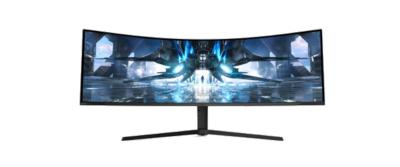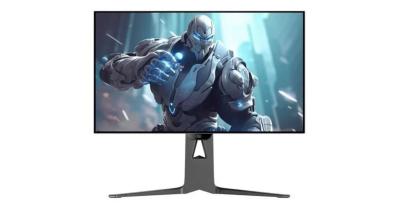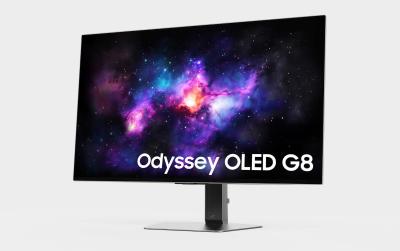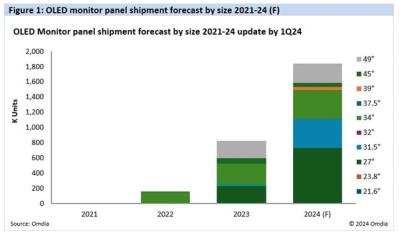OLED (Organic Light Emitting Diode) technology offers bright, efficient and fast displays, outperforming LCD display. OLEDs deliver the best picture quality ever and are used in many devices, from smartwatches through smartphones and tablets to TVs and more.
OLEDs are also used to enable high-end monitors that offer excellent contrast, image quality, colors and new form factors. This article will explain the benefits, the current status and the future of OLED monitors.
OLED monitors vs LCD monitors
- OLED provide a better image quality with a much higher contrast (true blacks), wide color gamut, better viewing angles and a much faster refresh rate (great for gaming!)
- OLED panels are much thinner and lighter compared to LCD panels
- OLED monitors consume less power - as only lit pixels draw energy on OLED displays
- An OLED monitor can be flexible, bendable, rollable - and transparent
Of course OLED technology is not perfect. One of the major drawbacks of an OLED display is image retention / burn-in. In an OLED display each pixel is driven independently and each pixel ages differently - and as brightness is reduced with use (the lifetime of OLED materials is limited), we have burn-in problems.
For mobile phones and TVs this is less of a problem - but in a computer user interface many UI elements are quite fixed (toolbars, icons, etc) which means that burn-in is a real problem. There are some technologies to handle this problem - for example by measurement and compensation, or by adopting a tandem architecture to increase the lifetime. In addition user-interface designers can design a user interface that will be more suited for OLED displays. As there are already millions of OLED monitors on the market, it seems that this problem has been mostly solved.
OLED monitors on the market
OLED technology is very popular in smartphones, wearables and TVs - and in recent years OLED monitors has entered the market as display makers now target this market, starting with high-end models aimed towards gaming and content creation. OLED producers, led by LG Display (WOLED) and Samsung Display (QD-OLED) are offering several high-end OLED panels for monitor makers, and today many leading monitor producers have already adopted OLED displays in their high-end models - including LG Electronics, Samsung, Viewsonic, Asus, Dell, Acer and more.
Click here for our comprehensive list of OLED monitors.
Further reading
Omdia: shipments of OLEDs over 9-inch in size will soar 124% in 2024
According to Omdia, sales of OLED panels in sizes over 9-inch (the company refers to these as Large Area Displays) will increase 124.6% in 2024. In 2023, the market contracted 25.7%, with the only exception being OLED monitor panels that grew in shipments.
In 2024, Omdia says that all application areas will see an increase in shipments - TVs, monitors, tablets and laptops. Only the company's "other" category will see a decrease in sales. In particular, tablet OLED shipments are projected to increase by 294% compared to 2023, largely due to Apple's adoption of OLEDs in the 2024 iPad Pro tablets. Laptop OLED sales will increase 152.6%, and monitors OLEDs will increase 139.9%. Finally, OLED TV panel shipments will increase 34.8%.
Samsung sold over 20,000 of its new QD-OLED gaming monitors in a month
Samsung Electronics says that a it has sold over 20,000 units of its new QD-OLED monitors, the Odyssey G8 and G6 in a month. The company says that the new monitors are popular in Europe, North America - and Southeast Asia.
A couple of months ago IDC says Samsung is leading the OLED monitor market, with a 34.7% market share by revenue (and 28.3% market share by shipments. Samsung Electronics started selling OLED monitors in 2023.
Is LG Display leading over Samsung Display with the quality and performance of its latest OLED?
Since Samsung started mass producing AMOLED displays in 2007, most people believe that the company is not only the leader in OLED production capacity, but also in the performance of its displays. In most cases, Samsung has been the first company to develop and manage to mass produce the most advanced OLED displays, and the first to adopt the latest OLED materials, architectures, and processes.
There are some signs that this could be changing, although honestly it's a bit too early to know. In May 2024, Apple launched its first OLED Tablets, and according to reports, Apple chose LG Display as its main supplier, ordering around 60% of its iPad OLEDs from LGD (with all of the 13" model orders going to LG), and the rest from Samsung. Later it was reported that Apple had to delay the introduction of its 2024 iPad Pro devices as Samsung faced low production yields and could not deliver displays in time.
DSCC sees OLED market revenues growing 12% in 2024 helped by Apple's first OLED tablets
DSCC says OLED revenues are expected to grow 12% in 2024 and reach $44 billion. OLED panel shipments will grow 18% in 2024. The fastest growing OLED market segments are tablets and monitors.
OLED tablet panel shipments will increase 202% in 2024, and this will result in a 632% increase in revenues, driven mostly by Appe's first adoption of OLED panels in its 13" and 11.1" iPad Pro tablets. OLED monitors will grow slower, but still impressively - 80% in shipments, and 45% in revenues.
DNP starts producing 8-Gen FMM masks at its new $140 million Kuosaki plant
Dai Nippon Printing (DNP) announced that it has started mass producing fine metal masks (FMM) at its new production line at Kurosaki Plant, in Fukuoka, Japan. DNP invested $140 million to expand the production line.
8-Gen and 6-Gen FMM samples (DNP)
The new production line is producing masks suitable for 8-Gen substrates. As the OLED industry is moving to expand its IT AMOLED display production for laptops, monitors and tablets, companies are building larger (8.7-Gen mostly) production lines that require these larger masks. While the company is already producing at the new fab, it will also announced that it may gradually expand production further at the new line, depending on market demand.
Visionox announces plans to build a $7.6 billion 8.6-Gen AMOLED line in Hefei
Visionox is the latest company to announce a new AMOLED production line, targeting the IT display market - laptops, monitors and tablets. The company said that it will best 55 billion Yuan (around $7.6 billion USD) to build a 8.6-Gen production line in Hefei, Anhui province.
Visionox's production line will have a monthly capacity of 32,000 substrates. The company did not share any details regarding the timeline of this project, or its financing.
Samsung Display says it shipped over a million QD-OLED monitor panels
Samsung Display announced that it shipped over a million QD-OLED monitor panels. SDC started producing these panels in 2022, and is currently offering a wide range of panels, from 27-inch to 49-inch, mostly targeting gaming monitors. SDC is working with 10 monitor producers, that have released over 90 QD-OLED monitor models.
Samsung says that it plans to expand its QD-OLED market, by targeting professional monitors and content creation monitors.
LG Display shows its latest OLED displays at Displayweek 2024
LG Display demonstrated its latest OLED display prototypes and commercial panels at Displayweek 2024. The company showed flexible panels, automotive displays, transparent OLED, gaming monitors, a 10k nit microdisplay and more.
So first up, LG Display shows its automotive Advanced-Thin-OLED (ATO) displays, which are produced on glass substrates and use a tandem structure. These OLEDs are lower in cost compared to LGD's flexible automotive p-OLED panels, but still enable low-weight and thin profile, and the excellent image quality of an OLED display. The smaller display was a 12.3" 2400x900 (209 PPI) 1,000 nits panel, while the other panel was larger at 17" 1920x2560 (188 PPI).
IDC: Samsung leads the OLED monitor market, with a 34.7% market share
Samsung Electronics started selling OLED monitors in 2023, and one year later, according to IDC, it leads the global OLED monitor market, with a 34.7% market share by revenues. It also is the leader in shipments with a share of 28.3%.

Samsung's first monitor was the 34" OLED G8, a QD-OLED gaming monitor. Since then Samsung released several new OLED monitors, and it's likely that the OLED Monitor market is set for fast growth ahead.
Omdia: OLED monitor shipments to rise 123% in 2024, following a 415% jump in 2023
Omdia says that OLED monitor shipments rose 415% in 2023, and the trend will continue in 2024, with a 123% increase over 2023. Total shipments in 2024 will reach 1.84 million units, driven mostly by Samsung Electronics and LG Display.
The main market for OLED Monitors is high-end gaming, especially esports. The entire monitor market has seen a downturn in 2023 and 2023, but Omdia says the market is expected to recover slowly in 2024.
Pagination
- Page 1
- Next page








